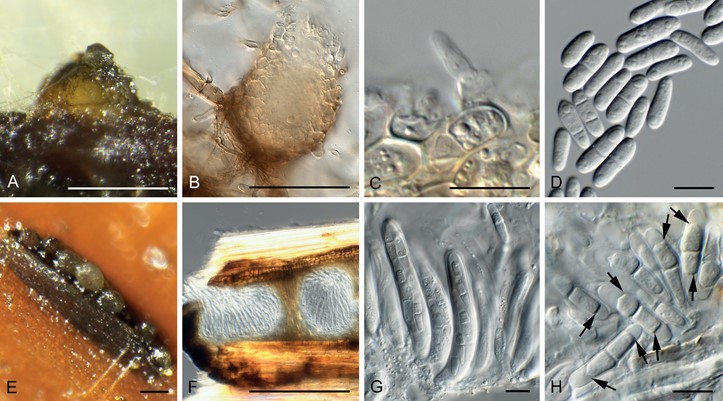Neoscirrhia osmundae (Peck & Clinton) Crous & R.K. Schumach., comb. nov.
MycoBank number: MB 839293; Index Fungorum number: IF 839293; Facesoffungi number: FoF 11518; Fig. 38.
Basionym: Dothidea osmundae Peck & Clinton, Rep. (Annual) New York State Mus. Nat. Hist. 30: 64. 1878. (1877)
Synonyms: Scirrhia osmundae (Peck & Clinton) Arx, in Müller & von Arx, Beitr. Kryptfl. Schweiz 11(no. 2): 382. 1962.
Metameris osmundae (Peck & Clinton) Arx & E. Müll., Stud. Mycol. 9: 80. 1975.
Scirrhia osmundae (Peck & Clinton) L. Holm & K. Holm, Bot. Notiser 131: 112. 1978, an isonym, see Art. 6.3 Note 2.
Ascomatapseudothecial, saprobic, gregarious,stromatic, immersed, becoming erumpent, opening by longitudinal split of epidermis, arranged parallel to the culm axis, black, thick- and smooth-walled, multi-locular, loculi in one row and one level, globose, black, soft, ostiole central, indistinct, up to 180 × 200 µm. Peridium multi- layered, of textura angularis-prismatica, inner layers hyaline, outer layers dark brown. Pseudoparaphyses numerous, partly evanescent, multi-celled, moniliform to cylindrical, branched, anastomosing. Asci 8-spored, subclavate to cylindrical, apically rounded with ocular chamber, pedicel short, broad and furcate, bitunicate, fissitunicate, 71–82 × 8.5–11.5 µm, ascospores obliquely biseriate. Ascospores straight to slightly curved, cells cylindrical, ends rounded, upper cell enlarged towards median septum, at times with lateral swelling just above the septum hyaline, thin- and smooth-walled, constricted at septum, cytoplasm aggregated in middle region, causing ends to appear very thick-walled, apex more prominently so than basal end, enclosed in mucilaginous sheath when immature (in water), 15.5–21.5 × 4–5 µm. Conidiomata pycnidial, globose, 250–300 µm diam, brown, with central ostiole, 30–40 µm diam, solitary on SNA, aggregated on OA; wall of 3–6 layers of brown textura angularis. Conidiophores reduced to conidiogenous cells lining inner cavity, hyaline, smooth, doliiform to ampulliform, phialidic, 5–7 × 5–6 µm. Conidia solitary, hyaline, smooth, prominently guttulate, medianly 1-septate, subcylindrical to obovoid, ends obtuse, (10–)12–14(–15) × (4–)4.5(–5) µm.
Culture characteristics: Colonies flat, spreading, with abundant aerial mycelium and smooth, even margin, covering dish after 2 wk at 25 °C. On MEA, PDA and OA surface and reverse olivaceous grey.
Material examined: Netherlands, Noord-Holland Province, Hoofddorp, on culms of Sasa veitchii (Poaceae), 18 May 2019, L. van der Linde, HPC 2956 = RKS 1103 (CBS H-24397, culture CPC 38085 = CBS 146803).
Notes: Scirrhia is based on S. rimosa, a species known from stems of Phragmites australis (Poaceae) collected in Europe. No culture was available so far and therefore the phylogenetic affinities were unresolved. Scirrhia brasiliensis is a morphologically similar species, recently described (on fronds of Pteridium aquilinum) in Brazil. It was shown to cluster in Mycosphaerellaceae (Crous et al. 2011), a family which type, S. rimosa, is expected to also belong to Schirrhia s.str. It is, however, quite distinct from S. osmundae, which has a different ascospore morphology (see below), and clusters in Didymellaceae.

Fig. 38. Neoscirrhia osmundae (CPC 38085). A. Conidioma on PNA. B. Conidioma with ostiole. C. Conidiogenous cells. D. Conidia. E–F. Ascomata on host tissue. G. Asci. H. Ascospores (arrows indicate apical thickenings). Scale bars: A = 300 µm, B, F = 200 µm, E = 180 µm, all others = 10 µm.
